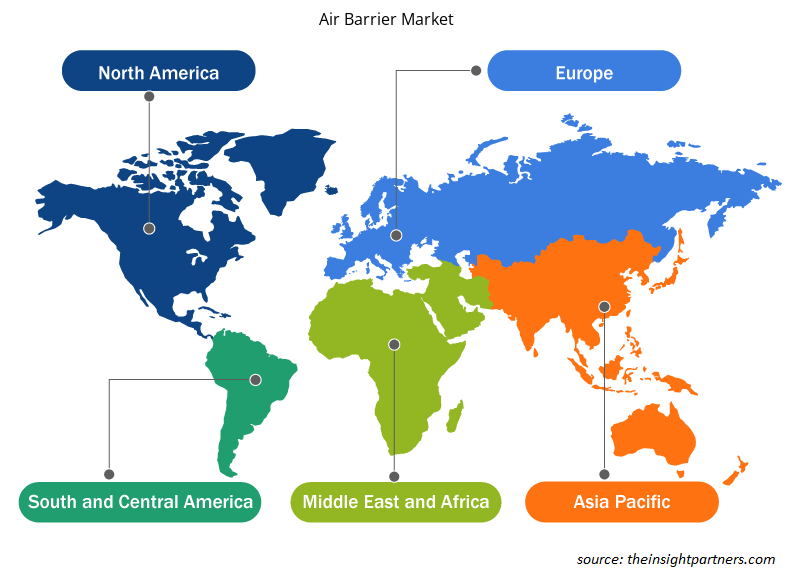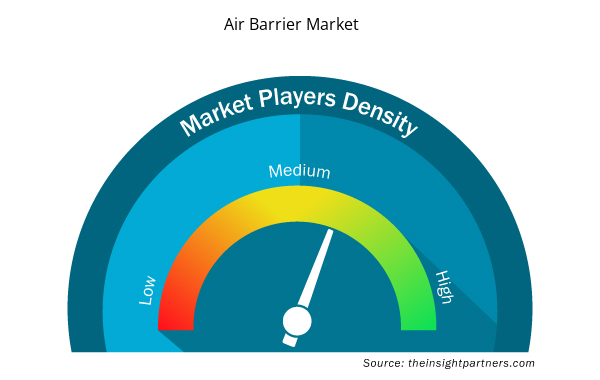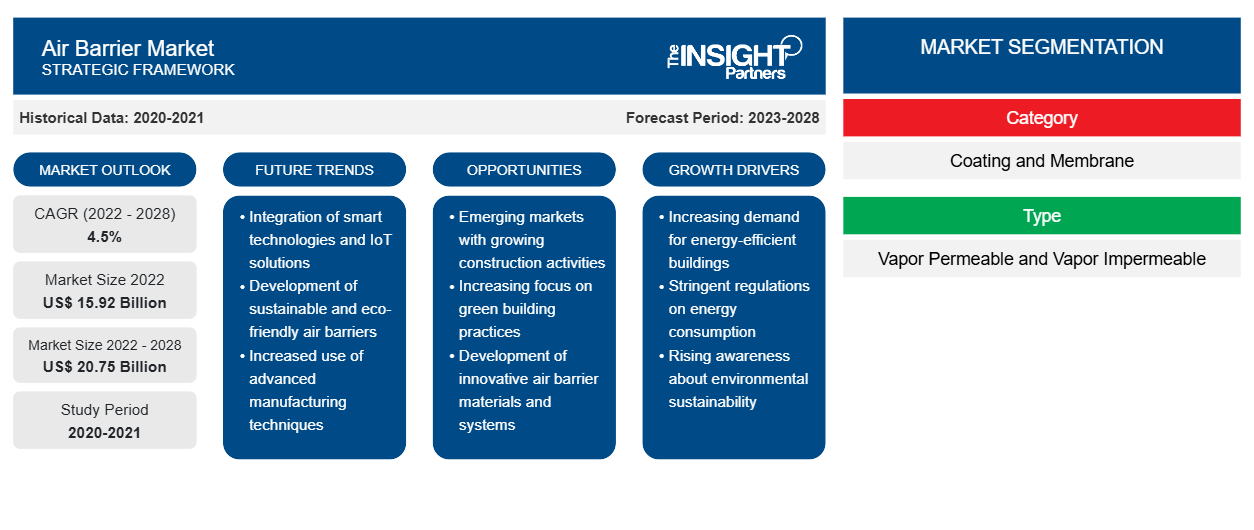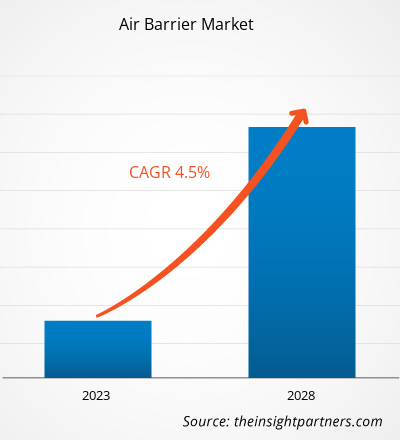[Informe de investigación] El tamaño del mercado de barreras de aire se valoró en US$ 15.924,68 millones en 2022; se espera que crezca a una CAGR del 4,5% entre 2022 y 2028.
La barrera de aire es un material que se utiliza para controlar el flujo de aire en los cerramientos de los edificios. Estos sistemas encierran completamente el aire dentro de un edificio. Las propiedades físicas que distinguen a las barreras de aire de otros materiales son la capacidad de resistir el flujo de aire y la presión. Las barreras de aire se pueden ubicar en cualquier lugar del cerramiento del edificio, en la superficie exterior, la superficie interior o en cualquier lugar intermedio. Las barreras de aire interiores en climas cálidos ayudan a controlar la exfiltración del interior, mientras que las barreras de aire exteriores controlan la infiltración de aire exterior y evitan que el viento traspase el aislamiento.
Impacto de la pandemia de COVID-19 en el mercado de barreras de aire
Antes de la pandemia de COVID-19, el mercado de barreras de aire en todo el mundo estaba impulsado principalmente por su creciente uso en los sectores de construcción residencial, comercial e industrial. Sin embargo, en 2020, varias industrias tuvieron que ralentizar sus operaciones debido a las interrupciones en las cadenas de valor causadas por el cierre de las fronteras nacionales e internacionales. La pandemia de COVID-19 afectó negativamente a las economías y las industrias debido a los cierres, las prohibiciones de viaje y los cierres de empresas. La pandemia de COVID-19 provocó interrupciones en la cadena de suministro de materias primas clave y obstaculizó los procesos de fabricación debido a las restricciones impuestas por las autoridades gubernamentales. La pandemia de COVID-19 trajo consigo impactos sin precedentes en la industria de la construcción, afectando negativamente al crecimiento del mercado de barreras de aire. Además, el material requerido en la industria de la construcción ha experimentado una inflación de precios debido a la interrupción de la cadena de suministro, el aumento de los costos laborales y la alta demanda.
Sin embargo, el mercado se está recuperando gracias a las importantes medidas adoptadas por los gobiernos de varios países. La industria de la construcción también está superando los desafíos de las interrupciones en la cadena de suministro de sus materias primas. La reanudación de las actividades de construcción a nivel mundial ha creado una demanda de barreras de aire.
Personalice este informe según sus necesidades
Obtendrá personalización en cualquier informe, sin cargo, incluidas partes de este informe o análisis a nivel de país, paquete de datos de Excel, así como también grandes ofertas y descuentos para empresas emergentes y universidades.
- Obtenga las principales tendencias clave del mercado de este informe.Esta muestra GRATUITA incluirá análisis de datos, desde tendencias del mercado hasta estimaciones y pronósticos.
Perspectivas del mercado
Diversas ventajas de utilizar barreras de aire
Los sistemas de barrera de aire ayudan a prevenir la pérdida de aire acondicionado. También ayudan a mantener alejados contaminantes como partículas suspendidas, polvo, alérgenos, insectos, olores y ruido. El moho se produce comúnmente en edificios donde el aire húmedo se acumula en componentes vulnerables de las paredes, incluido el aislamiento, el revestimiento exterior o los paneles de las paredes interiores. Esto puede afectar negativamente la calidad del aire interior y la salud de los ocupantes. Además, las barreras de aire ayudan a ahorrar energía. El ahorro de energía puede traducirse en un importante ahorro de costos. Además, las barreras de aire pueden aumentar el valor de los edificios comerciales al reducir los costos operativos. Por lo tanto, varias ventajas del uso de barreras de aire se traducen en una mayor adopción en los sectores residencial, comercial e industrial, impulsando así su mercado.
Perspectivas de la categoría
Según la categoría, el mercado de barreras de aire se segmenta en revestimientos y membranas. El segmento de revestimientos tuvo una mayor participación en el mercado de barreras de aire en 2021. El revestimiento de barrera de aire se rocía o se aplica con rodillo sobre el sustrato de la pared. Ayuda a ahorrar costos de mano de obra durante la instalación. Las barreras de aire se utilizan fácilmente para geometrías de sustrato complejas. Son eficientes para adherirse e impermeabilizar diversas condiciones de pared.
Tipo de información
Según el tipo, el mercado de barreras de aire se segmenta en permeables al vapor e impermeables al vapor. El segmento impermeable al vapor tuvo una mayor participación en el mercado de barreras de aire en 2021. Las barreras de aire impermeables al vapor están diseñadas para bloquear el vapor de humedad y el aire, sin permitir prácticamente el paso de vapor de agua a través del material. Estos son factores vitales que impulsan la demanda de barreras de aire impermeables al vapor.
Los actores clave que operan en el mercado incluyen BASF SE, Dow Inc, 3M, WR Meadows Inc, GCP Applied Technologies Inc, CertainTeed LLC, Tamarack Materials Inc, VaproShield LLC, TK Products Construction Coating, Henry Co, Carlisle Companies Inc y General Electric Co. Los actores que operan en el mercado se centran en proporcionar productos de alta calidad para satisfacer la demanda de los clientes. También se centran en estrategias como inversiones en actividades de investigación y desarrollo y lanzamientos de nuevos productos.
Perspectivas regionales del mercado de barreras de aire
Los analistas de Insight Partners explicaron en detalle las tendencias y los factores regionales que influyen en el mercado de barreras de aire durante el período de pronóstico. Esta sección también analiza los segmentos y la geografía del mercado de barreras de aire en América del Norte, Europa, Asia Pacífico, Oriente Medio y África, y América del Sur y Central.

- Obtenga los datos regionales específicos para el mercado de barreras de aire
Alcance del informe de mercado de barreras de aire
| Atributo del informe | Detalles |
|---|---|
| Tamaño del mercado en 2022 | US$ 15,92 mil millones |
| Tamaño del mercado en 2028 | US$ 20,75 mil millones |
| CAGR global (2022-2028) | 4,5% |
| Datos históricos | 2020-2021 |
| Período de pronóstico | 2023-2028 |
| Segmentos cubiertos | Por categoría
|
| Regiones y países cubiertos | América del norte
|
| Líderes del mercado y perfiles de empresas clave |
|
Densidad de actores del mercado de barreras de aire: comprensión de su impacto en la dinámica empresarial
El mercado de barreras de aire está creciendo rápidamente, impulsado por la creciente demanda de los usuarios finales debido a factores como la evolución de las preferencias de los consumidores, los avances tecnológicos y una mayor conciencia de los beneficios del producto. A medida que aumenta la demanda, las empresas amplían sus ofertas, innovan para satisfacer las necesidades de los consumidores y aprovechan las tendencias emergentes, lo que impulsa aún más el crecimiento del mercado.
La densidad de actores del mercado se refiere a la distribución de las empresas o firmas que operan dentro de un mercado o industria en particular. Indica cuántos competidores (actores del mercado) están presentes en un espacio de mercado determinado en relación con su tamaño o valor total de mercado.
Las principales empresas que operan en el mercado de barreras de aire son:
- BASF SE
- Dow Inc
- Compañía 3M
- WR Meadows Inc
- Tecnologías Aplicadas GCP Inc.
Descargo de responsabilidad : Las empresas enumeradas anteriormente no están clasificadas en ningún orden particular.

- Obtenga una descripción general de los principales actores clave del mercado Air Barrier
Informe Destacado
- Tendencias progresivas de la industria en el mercado de barreras de aire para ayudar a los actores a desarrollar estrategias efectivas a largo plazo
- Estrategias de crecimiento empresarial adoptadas por los mercados desarrollados y en desarrollo
- Análisis cuantitativo del mercado de barreras de aire de 2020 a 2028
- Estimación de la demanda de barreras de aire
- Análisis PEST para ilustrar la eficacia de los compradores y proveedores que operan en la industria
- Avances recientes para comprender el escenario competitivo del mercado
- Tendencias y perspectivas del mercado, así como factores que impulsan y restringen el crecimiento del mercado de barreras de aire
- Asistencia en el proceso de toma de decisiones destacando las estrategias de mercado que sustentan el interés comercial, lo que conduce al crecimiento del mercado.
- El tamaño del mercado de barreras de aire en varios nodos
- Descripción detallada y segmentación del mercado y la dinámica de la industria de productos químicos y materiales.
- El tamaño del mercado de barreras de aire en varias regiones con oportunidades de crecimiento prometedoras
Según la categoría, el mercado de barreras de aire se segmenta en revestimientos y membranas. En términos de tipo, el mercado se segmenta en permeables al vapor e impermeables al vapor. Según la aplicación, el mercado se segmenta en residencial, comercial e industrial.
Perfiles de empresas
- BASF SE
- Dow Inc
- 3M
- WR Meadows Inc
- Tecnologías Aplicadas GCP Inc.
- CertainTeed LLC
- Materiales Tamarack Inc.
- VaproShield LLC
- Recubrimientos para la construcción de productos TK
- Compañía Henry
- Compañías Carlisle Inc.
- Compañía General Electric
- Análisis histórico (2 años), año base, pronóstico (7 años) con CAGR
- Análisis PEST y FODA
- Tamaño del mercado Valor/volumen: global, regional, nacional
- Industria y panorama competitivo
- Conjunto de datos de Excel


- Online Recruitment Market
- Hydrolyzed Collagen Market
- Biopharmaceutical Contract Manufacturing Market
- Surgical Gowns Market
- Nuclear Waste Management System Market
- Oxy-fuel Combustion Technology Market
- Europe Industrial Chillers Market
- Smart Mining Market
- Intraoperative Neuromonitoring Market
- Data Annotation Tools Market

Report Coverage
Revenue forecast, Company Analysis, Industry landscape, Growth factors, and Trends

Segment Covered
This text is related
to segments covered.

Regional Scope
North America, Europe, Asia Pacific, Middle East & Africa, South & Central America

Country Scope
This text is related
to country scope.
Preguntas frecuentes
Based on application, residential is the fastest-growing segment.
Increasing advantages of using air barriers for various applications and the growth of the residential construction sector are some of the key driving factors for the air barriers market.
Asia Pacific accounted for the largest share of the global air barrier market owing to the presence of a strong industrial base that is making this region the workshop of the world. As regional pollution increases, air barriers will become essential in these areas.
Based on the type, the vapor impermeable segment accounted for the largest revenue share owing to its property of blocking moisture vapor and air while allowing virtually no passage of water vapor through the material.
Manufacturers are making significant investments in research & development, partnerships, and collaborations to launch innovative products to tap into emerging market opportunities.
The major players operating in the global air barrier market are Cargill, Incorporated; Tate & Lyle PLC; AGRANA Beteiligungs-AG; Manildra Group; Roquette Frères; Sinofi Ingredients; Tokai Denpun Co., Ltd.; Sanwa Starch Co., Ltd.; New Zealand Starch Limited; and SAMYANG CORPORATION among few others.
The List of Companies - Air Barrier Market
- BASF SE
- Dow Inc
- 3M Co
- W. R. Meadows Inc
- GCP Applied Technologies Inc
- CertainTeed LLC
- Tamarack Materials Inc
- VaproShield LLC
- TK Products Construction Coating
- Henry Co
The Insight Partners performs research in 4 major stages: Data Collection & Secondary Research, Primary Research, Data Analysis and Data Triangulation & Final Review.
- Data Collection and Secondary Research:
As a market research and consulting firm operating from a decade, we have published and advised several client across the globe. First step for any study will start with an assessment of currently available data and insights from existing reports. Further, historical and current market information is collected from Investor Presentations, Annual Reports, SEC Filings, etc., and other information related to company’s performance and market positioning are gathered from Paid Databases (Factiva, Hoovers, and Reuters) and various other publications available in public domain.
Several associations trade associates, technical forums, institutes, societies and organization are accessed to gain technical as well as market related insights through their publications such as research papers, blogs and press releases related to the studies are referred to get cues about the market. Further, white papers, journals, magazines, and other news articles published in last 3 years are scrutinized and analyzed to understand the current market trends.
- Primary Research:
The primarily interview analysis comprise of data obtained from industry participants interview and answers to survey questions gathered by in-house primary team.
For primary research, interviews are conducted with industry experts/CEOs/Marketing Managers/VPs/Subject Matter Experts from both demand and supply side to get a 360-degree view of the market. The primary team conducts several interviews based on the complexity of the markets to understand the various market trends and dynamics which makes research more credible and precise.
A typical research interview fulfils the following functions:
- Provides first-hand information on the market size, market trends, growth trends, competitive landscape, and outlook
- Validates and strengthens in-house secondary research findings
- Develops the analysis team’s expertise and market understanding
Primary research involves email interactions and telephone interviews for each market, category, segment, and sub-segment across geographies. The participants who typically take part in such a process include, but are not limited to:
- Industry participants: VPs, business development managers, market intelligence managers and national sales managers
- Outside experts: Valuation experts, research analysts and key opinion leaders specializing in the electronics and semiconductor industry.
Below is the breakup of our primary respondents by company, designation, and region:

Once we receive the confirmation from primary research sources or primary respondents, we finalize the base year market estimation and forecast the data as per the macroeconomic and microeconomic factors assessed during data collection.
- Data Analysis:
Once data is validated through both secondary as well as primary respondents, we finalize the market estimations by hypothesis formulation and factor analysis at regional and country level.
- Macro-Economic Factor Analysis:
We analyse macroeconomic indicators such the gross domestic product (GDP), increase in the demand for goods and services across industries, technological advancement, regional economic growth, governmental policies, the influence of COVID-19, PEST analysis, and other aspects. This analysis aids in setting benchmarks for various nations/regions and approximating market splits. Additionally, the general trend of the aforementioned components aid in determining the market's development possibilities.
- Country Level Data:
Various factors that are especially aligned to the country are taken into account to determine the market size for a certain area and country, including the presence of vendors, such as headquarters and offices, the country's GDP, demand patterns, and industry growth. To comprehend the market dynamics for the nation, a number of growth variables, inhibitors, application areas, and current market trends are researched. The aforementioned elements aid in determining the country's overall market's growth potential.
- Company Profile:
The “Table of Contents” is formulated by listing and analyzing more than 25 - 30 companies operating in the market ecosystem across geographies. However, we profile only 10 companies as a standard practice in our syndicate reports. These 10 companies comprise leading, emerging, and regional players. Nonetheless, our analysis is not restricted to the 10 listed companies, we also analyze other companies present in the market to develop a holistic view and understand the prevailing trends. The “Company Profiles” section in the report covers key facts, business description, products & services, financial information, SWOT analysis, and key developments. The financial information presented is extracted from the annual reports and official documents of the publicly listed companies. Upon collecting the information for the sections of respective companies, we verify them via various primary sources and then compile the data in respective company profiles. The company level information helps us in deriving the base number as well as in forecasting the market size.
- Developing Base Number:
Aggregation of sales statistics (2020-2022) and macro-economic factor, and other secondary and primary research insights are utilized to arrive at base number and related market shares for 2022. The data gaps are identified in this step and relevant market data is analyzed, collected from paid primary interviews or databases. On finalizing the base year market size, forecasts are developed on the basis of macro-economic, industry and market growth factors and company level analysis.
- Data Triangulation and Final Review:
The market findings and base year market size calculations are validated from supply as well as demand side. Demand side validations are based on macro-economic factor analysis and benchmarks for respective regions and countries. In case of supply side validations, revenues of major companies are estimated (in case not available) based on industry benchmark, approximate number of employees, product portfolio, and primary interviews revenues are gathered. Further revenue from target product/service segment is assessed to avoid overshooting of market statistics. In case of heavy deviations between supply and demand side values, all thes steps are repeated to achieve synchronization.
We follow an iterative model, wherein we share our research findings with Subject Matter Experts (SME’s) and Key Opinion Leaders (KOLs) until consensus view of the market is not formulated – this model negates any drastic deviation in the opinions of experts. Only validated and universally acceptable research findings are quoted in our reports.
We have important check points that we use to validate our research findings – which we call – data triangulation, where we validate the information, we generate from secondary sources with primary interviews and then we re-validate with our internal data bases and Subject matter experts. This comprehensive model enables us to deliver high quality, reliable data in shortest possible time.


 Obtenga una muestra gratuita de este informe
Obtenga una muestra gratuita de este informe